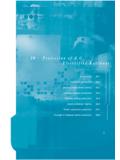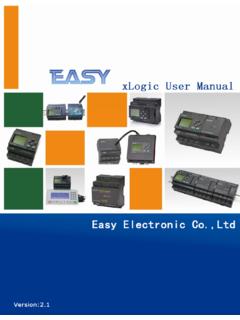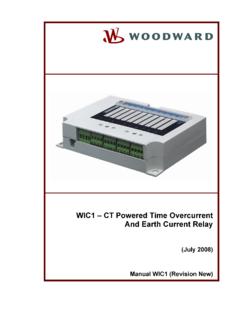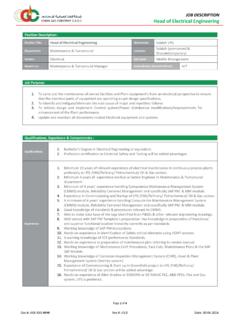Transcription of 21 Relay Testing and Commissioning - fecime.org
1 Type compatibility safety type type type validation type injection test equipment injection Testing injection Testing of protection scheme logic and alarm annunciation tests maintenance tests scheme design for maintenance 21 Relay Testingand INTRODUCTIONThe Testing of protection equipment schemes presents anumber of problems. This is because the main functionof protection equipment is solely concerned withoperation under system fault conditions, and cannotreadily be tested under normal system operatingconditions. This situation is aggravated by theincreasing complexity of protection schemes and use ofrelays containing Testing of protection equipment may be divided intofour factory production maintenance Type TestsType tests are required to prove that a Relay meets thepublished specification and complies with all relevantstandards.
2 Since the principal function of a protectionrelay is to operate correctly under abnormal powerconditions, it is essential that the performance beassessed under such conditions. Comprehensive typetests simulating the operational conditions are thereforeconducted at the manufacturer's works during thedevelopment and certification of the standards that cover most aspects of relayperformance are IEC 60255 and ANSI Howevercompliance may also involve consideration of therequirements of IEC 61000, 60068 and 60529, whileproducts intended for use in the EEC also have to complywith the requirements of Directives 89/336/EEC and73/23/EEC.
3 Since type Testing of a digital or numericalrelay involves Testing of software as well as hardware,the type Testing process is very complicated and moreinvolved than a static or electromechanical Relay . 21 Relay Testingand CommissioningNetwork Protection & Automation Guide 371 Routine Factory Production TestsThese are conducted to prove that relays are free fromdefects during manufacture. Testing will take place atseveral stages during manufacture, to ensure problemsare discovered at the earliest possible time and henceminimise remedial work. The extent of Testing will bedetermined by the complexity of the Relay and pastmanufacturing Commissioning TestsThese tests are designed to prove that a particularprotection scheme has been installed correctly prior tosetting to work.
4 All aspects of the scheme arethoroughly checked, from installation of the correctequipment through wiring checks and operation checksof the individual items of equipment, finishing withtesting of the complete Periodic Maintenance ChecksThese are required to identify equipment failures anddegradation in service, so that corrective action can betaken. Because a protection scheme only operates underfault conditions, defects may not be revealed for asignificant period of time, until a fault occurs. Regulartesting assists in detecting faults that would otherwiseremain undetected until a fault ELECTRICAL TYPE TESTSV arious electrical type tests must be performed, Functional TestsThe functional tests consist of applying the appropriateinputs to the Relay under test and measuring theperformance to determine if it meets the are usually carried out under controlledenvironmental conditions.
5 The Testing may be extensive,even where only a simple Relay function is being tested.,as can be realised by considering the simple overcurrentrelay element of Table determine compliance with the specification, the testslisted in Table are required to be carried out. This isa time consuming task, involving many engineers andtechnicians. Hence it is a modern numerical Relay with many functions isconsidered, each of which has to be type-tested, thefunctional type- Testing involved is a major issue. In thecase of a recent Relay development project, it wascalculated that if one person had to do all the work, itwould take 4 years to write the functional type-testspecifications, 30 years to perform the tests and severalyears to write the test reports that result.
6 Automatedtechniques/ equipment are clearly required, and arecovered in Section 21 Relay Testing and CommissioningNetwork Protection & Automation Guide 372 ElementRangeStep SizeI> - > - to +95 1 CharacteristicDT/IDMTD efinite Time Delay0 - IDMT Time DelayIEC Standard InverseIEC Very InverseIEC Extremely InverseUK Long Time InverseTime Multiplier Setting (TMS) - Moderately InverseIEEE Very InverseIEEE IDMT Time DelayIEEE Extremely InverseUS-CO8 InverseUS-CO2 Short Time InverseTime Dial (TD) - Reset Time (DT only)0 - Reset TimeIDMT/DTIEEE DT Reset Time0 - Moderately InverseIEEE Very InverseIEEE IDMT Reset TimeIEEE Extremely InverseUS-CO8 InverseUS-CO2 Short Time InverseTable : Overcurrent Relay element specificationTable.
7 Overcurrent Relay element functional type testsTest 1 Test 2 Test 3 Test 4 Test 5 Test 6 Test 7 Test 8 Test 9 Test 10 Test 11 Test 12 Test 13 Test 14 Three phase non-directional pick up and drop off accuracyover complete current setting range for both stagesThree phase directional pick up and drop off accuracyover complete RCA setting range in the forward direction,current angle sweepThree phase directional pick up and drop off accuracyover complete RCA setting range in the reverse direction,current angle sweepThree phase directional pick up and drop off accuracyover complete RCA setting range in the forward direction,voltage angle sweepThree phase directional pick up and drop off accuracyover complete RCA setting range in the reverse direction,voltage angle sweepThree phase polarising voltage threshold testAccuracy of DT timer over complete setting rangeAccuracy of IDMT curves over claimed accuracy rangeAccuracy of IDMT TMS/TDEffect of changing fault current on IDMT operating timesMinimum Pick-Up of Starts and Trips for IDMT curvesAccuracy of reset timersEffect of any blocking signals, opto inputs, VTS.
8 AutorecloseVoltage polarisation Rating TestsRating type tests are conducted to ensure thatcomponents are used within their specified ratings andthat there are no fire or electric shock hazards under anormal load or fault condition of the power system. Thisis in addition to checking that the product complies withits technical specification. The following are amongstthe rating type tests conducted on protection relays, thespecified parameters are normally to IEC Thermal WithstandThe thermal withstand of VT s, CT s and output contactcircuits is determined to ensure compliance with thespecified continuous and short-term overload addition to functional verification, the pass criterion isthat there is no detrimental effect on the Relay assembly,or circuit components.
9 When the product is subjected tooverload conditions that may be expected in withstand is assessed over a time period of 1sfor CT s and 10s for VT Relay BurdenThe burdens of the auxiliary supply, optically isolatedinputs, VT s and CT s are measured to check that theproduct complies with its specification. The burden ofproducts with a high number of input/output circuits isapplication specific it increases according to thenumber of optically isolated input and output contactports which are energised under normal power systemload conditions. It is usually envisaged that not morethan 50% of such ports will be energised in Relay InputsRelay inputs are tested over the specified ranges.
10 Inputsinclude those for auxiliary voltage, VT, CT, frequency,optically isolated digital inputs and Relay Output ContactsProtection Relay output contacts are type tested toensure that they comply with the product withstand and endurance type tests have to becarried out using , since the normal supply is via astation Insulation ResistanceThe insulation resistance test is carried out according toIEC 60255-5, 500V 10%, for a minimum of 5seconds. This is carried out between all circuits and caseearth, between all independent circuits and acrossnormally open contacts. The acceptance criterion for aproduct in new condition is a minimum of 100M.


















